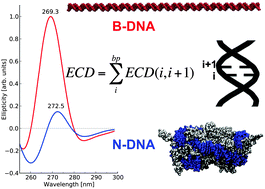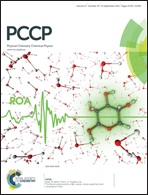Predicting near-UV electronic circular dichroism in nucleosomal DNA by means of DFT response theory†
Abstract
It is demonstrated that time-dependent density functional theory (DFT) calculations can accurately predict changes in near-UV electronic circular dichroism (ECD) spectra of DNA as the structure is altered from the linear (free) B-DNA form to the supercoiled N-DNA form found in nucleosome core particles. At the DFT/B3LYP level of theory, the ECD signal response is reduced by a factor of 6.7 in going from the B-DNA to the N-DNA form, and it is illustrated how more than 90% of the individual base-pair dimers contribute to this strong hypochromic effect. Of the several inter-base pair parameters, an increase in twist angles is identified as to strongly contribute to a reduced ellipticity. The present work provides first evidence that first-principles calculations can elucidate changes in DNA dichroism due to the supramolecular organization of the nucleoprotein particle and associates these changes with the local structural features of nucleosomal DNA.


 Please wait while we load your content...
Please wait while we load your content...